Tom Thomson (1877–1917) is included in all the general histories of Canadian art and in most books on the Group of Seven. In addition, several books and articles focus on him alone. Unfortunately, he wrote few letters, and the only first-hand accounts of him come from his friends in the group and from comments made by rangers and others in Algonquin Park who knew him. As would be expected for Canada’s best-loved painter, his exhibition history is rich.
Key Exhibitions
Memorial exhibitions of Thomson’s work following his death were organized in Montreal, Ottawa, and Toronto. Thereafter his works were usually shown in group or survey exhibitions, the most important of which were the British Empire Exhibitions at Wembley Park, London, in 1924 and 1925, and Painting Canada: Tom Thomson and the Group of Seven at the Dulwich Picture Gallery, London, 2011–12. The first ambitious retrospective was organized by Joan Murray at the Art Gallery of Ontario, Toronto, in 1971. Thirty years passed before the National Gallery of Canada, Ottawa, and the Art Gallery of Ontario, collaborated on a major travelling retrospective in 2002, an exhibition that provided much new research by a phalanx of curators.
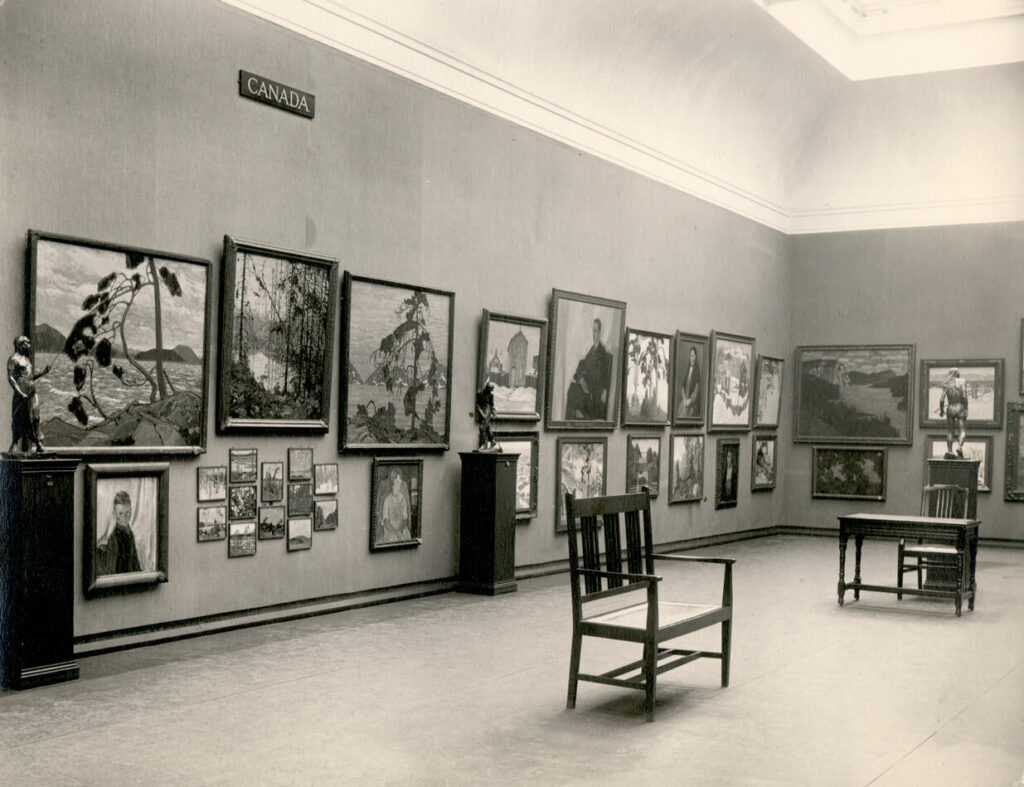
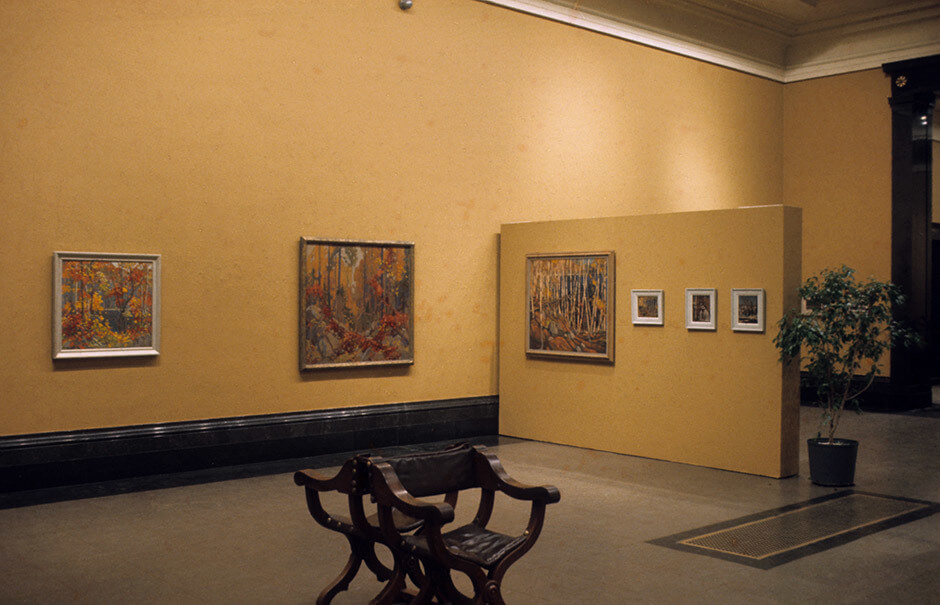
1913
April 5–26, 1913, Ontario Society of Artists, 41st Annual Exhibition, Art Museum of Toronto. Thomson exhibited for the first time at this exhibition, and his painting Northern Lake, 1912–13, was purchased by the Government of Ontario for $250.
1914
Ontario Society of Artists, 42nd Annual Exhibition, Art Museum of Toronto. From this exhibition the National Gallery of Canada purchased Moonlight, 1913–14, for $150, its first of several purchases during Thomson’s lifetime.
1915
March 13–April 10, 1915, Ontario Society of Artists, 43rd Annual Exhibition, Art Museum of Toronto. The National Gallery of Canada bought Northern River, 1914–15, from this exhibition for $500.
1916
March 11–April 15, 1916, Ontario Society of Artists, 44th Annual Exhibition, Art Museum of Toronto. The National Gallery of Canada purchased Spring Ice, 1915–16, from this exhibition for $300.
1917
December 1917, Tom Thomson, Arts and Letters Club, Toronto.
1919
March 1–21, 1919, Exhibition of Paintings by the Late Tom Thomson, Arts Club, Montreal. Travelled to Art Association of Montreal, March 25–April 12.
1920
February 14–29, 1920, Memorial Exhibition of Paintings by Tom Thomson, Art Gallery of Toronto. The Group of Seven was formed shortly after the exhibition closed.
1923
November–December 1923, Exhibition of Tom Thomson Sketches, Hart House, University of Toronto.
1924
April 23–October 31, 1924, British Empire Exhibition, Wembley Park, London. Thomson is singled out by British art critics as a major artist.
1925
May–October 1925, British Empire Exhibition, Wembley Park, London.
1938
October 15–December 15, 1938, A Century of Canadian Art, Tate Gallery, London.
1955
November–December 1957, Tom Thomson Travelling Exhibition: Sketches and Painting from the National Gallery of Canada Collection. In chronological order: Edmonton Museum of Arts; Calgary Allied Arts Centre; University of Manitoba, Winnipeg; Southern Alberta Art Gallery, Lethbridge; Art Gallery of Greater Victoria; University of British Columbia, Fine Arts Gallery, Vancouver; Regina Public Library; Winnipeg Art Gallery; Sarnia Public Library; Kitchener-Waterloo Art Association; Yarmouth Art Society; Colchester Chapter of the IODE, Truro; Louisbourg Chapter of the IODE; Amherst Art Association; Moncton Society of Art; Fredericton Art Club; University of New Brunswick, Fredericton; Art Centre, Saint John, New Brunswick; Dalhousie University, Halifax; Nova Scotia College of Art, Halifax; Glenhyrst Gardens, Brantford; London Public Library and Art Museum; Willistead Library and Art Gallery, Windsor; Winnipeg Art Gallery.
1971
October 10–December 13, 1971, The Art of Tom Thomson, Art Gallery of Ontario. This was the first retrospective exhibition of Thomson’s work.
1977
May 4–June 1, 1977, The Tom Thomson Memorial Exhibition, Tom Thomson Memorial Gallery and Museum of Fine Art, Owen Sound.
2002
June 7–September 8, 2002, Tom Thomson, National Gallery of Canada. Travelled to Vancouver, Edmonton, Quebec City, and Toronto.
2011–12
October 19, 2011–January 8, 2012, Painting Canada: Tom Thomson and the Group of Seven, Dulwich Picture Gallery, London. Travelled to the National Museum, Oslo, Norway; the Groninger Museum, Groningen, The Netherlands; and the McMichael Canadian Art Collection, Kleinburg, Ontario.
Books
The Thomson canon includes exhibition catalogues, beautiful art books, and personal recollections. Surprisingly, given the artist’s stature, there have been few critical studies.

Addison, Ottelyn. Tom Thomson: The Algonquin Years. Toronto: Ryerson Press, 1969.
Colgate, William. Canadian Art: Its Origins and Development. Toronto: Ryerson Press, 1943.
Davies, Blodwen. Paddle and Palette: The Story of Tom Thomson. Notes on the pictures prepared by Arthur Lismer. Toronto: Ryerson Press, 1930.
Dejardin, Ian, et al. Painting Canada: Tom Thomson and the Group of Seven. Edited by Amy Concannon. London: Philip Wilson Publishers. The catalogue for the exhibition in 2011–12 at the Dulwich Picture Gallery, London.
Grace, Sherrill.Inventing Tom Thomson: From Biographical Fictions to Fictional Autobiographies and Reproductions. Montreal: McGill-Queen’s University Press, 2004.
Harper, J. Russell. Painting in Canada: A History. Toronto: University of Toronto Press, 1966.
Harris, Lawren. “The Group of Seven in Canadian History.” In Canadian Historical Society, Report of the Annual Meeting Held at Victoria and Vancouver, June 16–19, 1948. Edited by R.A. Preston. Toronto: University of Toronto Press, 1948.
———. The Story of the Group of Seven. Toronto: Rous and Mann Press, 1964. This account is more reliable than the one in A.Y. Jackson’s autobiography A Painter’s Country.
Housser, F.B.A Canadian Art Movement: The Story of the Group of Seven. Toronto: Macmillan, 1926.
Jackson, A.Y.A Painter’s Country. Toronto: Clarke, Irwin, 1958. Paperback edition, 1964.
King, Ross. Defiant Spirits: The Modernist Revolution of the Group of Seven. Vancouver: Douglas & McIntyre, 2010.
Lismer, Arthur.Tom Thomson: The Story of a Man Who Looked for Beauty and for the Truth in the Wilderness. Vancouver: Mitchell Press, 1967.
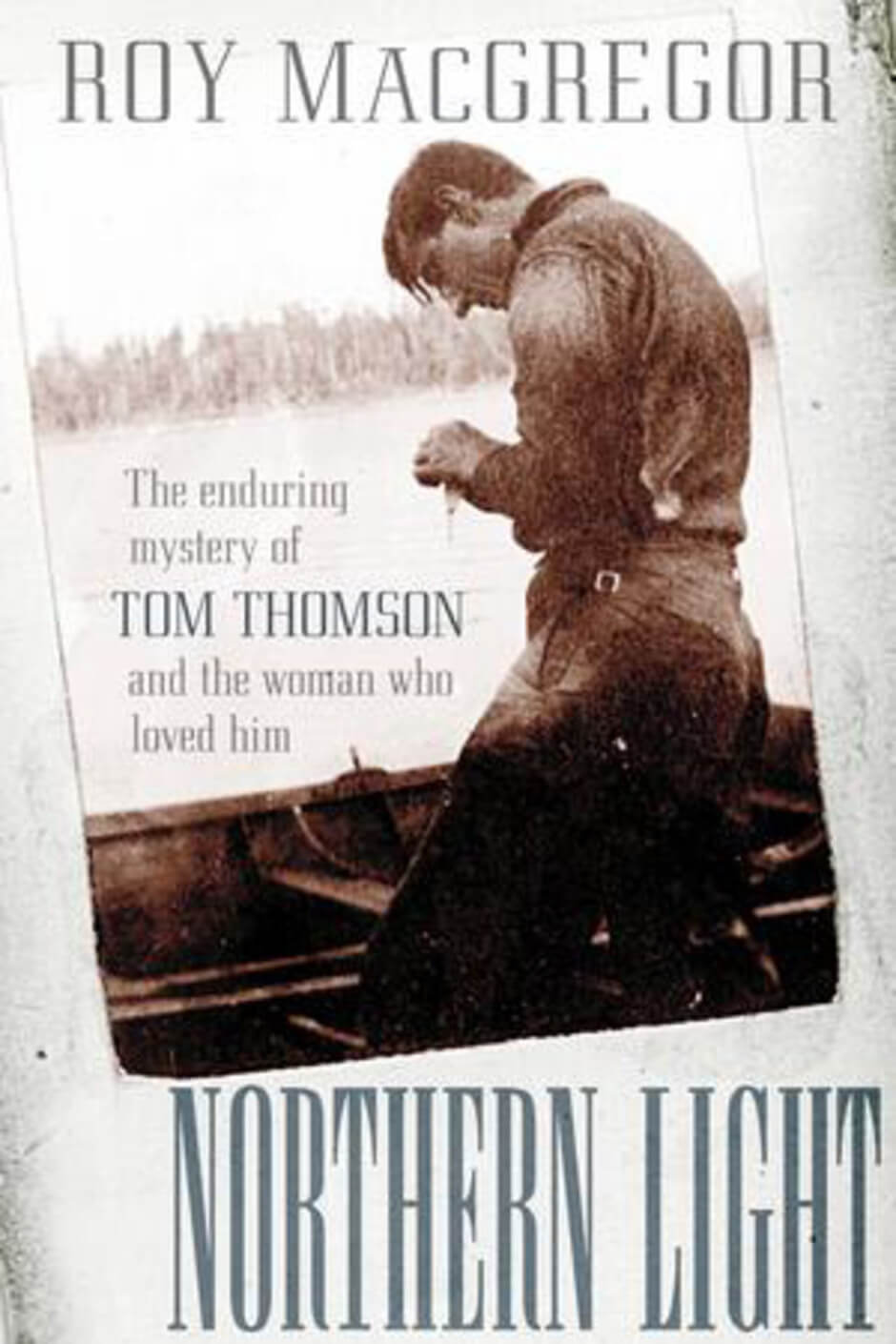
MacGregor, Roy. Northern Light: The Enduring Mystery of Tom Thomson and the Woman Who Loved Him. Toronto: Penguin Canada, 2010.
MacTavish, Newton. The Fine Arts in Canada. Toronto: Macmillan, 1925.
McInnis, Graham C. Canadian Art. Toronto: Macmillan, 1950.
McKay, Marylin J. Picturing the Land: Narrating Territories in Canadian Landscape Art, 1500–1950. Montreal: McGill-Queen’s University Press, 2011.
Mellen, Peter. The Group of Seven. Toronto: McClelland & Stewart, 1970.
Millard, Laura. Algonquin Memories: Tom Thomson in Algonquin Park. Owen Sound, ON: Thomson Books, 1998. Exhibition catalogue organized by Tom Thomson Art Gallery for Algonquin Gallery.
Murray, Joan. The Art of Tom Thomson. Toronto: Art Gallery of Ontario, 1971. Exhibition catalogue.
———. Tom Thomson: Catalogue Raisonné. http://www.tomthomsoncatalogue.org, 2015. Catalogue Raisonné, including paintings, drawings, and commercial art.
———. A Treasury of Tom Thomson. Vancouver: Douglas & McIntyre, 2011.
O’Brian, John, and Peter White.Beyond Wilderness: The Group of Seven, Canadian Identity, and Contemporary Art. Montreal: McGill-Queen’s University Press, 2007.
Reid, Dennis. Tom Thomson: The Jack Pine. Ottawa: National Gallery of Canada, National Museum of Canada, 1975.
Reid, Dennis, and Charles C. Hill, eds. Tom Thomson. Vancouver: Douglas & McIntyre, 2002. An indispensable resource, with essays by a number of curators on different aspects of Thomson’s life and work. Included in the new research they present are the results of extensive studies of Thomson’s paintings, using equipment such as X-rays, spectrometers, and micro-pigment analysis. In addition, Charles Hill, the foremost authority on Thomson, sets out a plausible dating of the paintings of Thomson’s last five years.

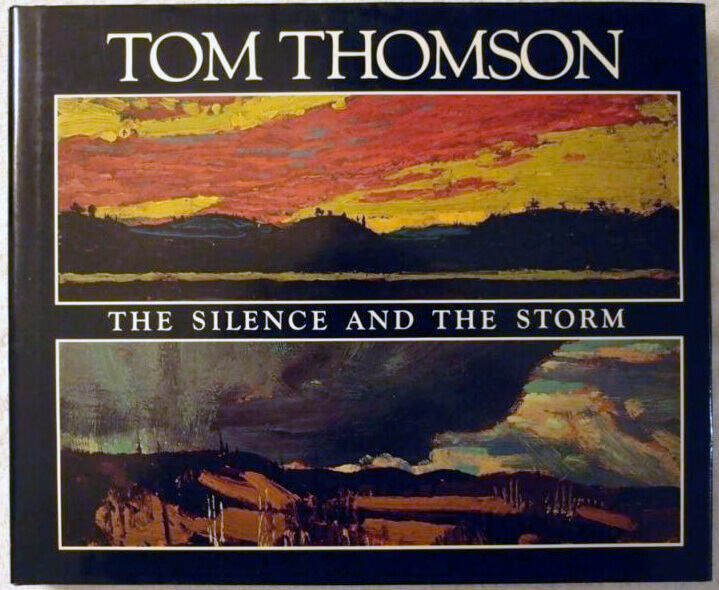
Robson, Albert Henry. Tom Thomson. Toronto: Ryerson Press, 1937. A good personal recollection.
Silcox, David P. Tom Thomson: An Introduction to His Life and Art. Willowdale, ON: Firefly Books, 2002.
———. The Group of Seven and Tom Thomson. Richmond Hill, ON: Firefly Books, 2003.
Silcox, David P., and Harold Town. Tom Thomson: The Silence and the Storm. 5th ed. Toronto: HarperCollins Canada, forthcoming 2016.
This book, an earlier edition of which is available in French, presents the largest number of Thomson’s paintings, photographs, and ancillary works in print.
Articles
Bordo, Jonathan. “Jack Pine: Wilderness Sublime or the Erasure of the Aboriginal Presence from the Canadian Landscape.” Journal of Canadian Studies 27, no 4 (1992–93): 98–128.
Cameron, Ross D. “Tom Thomson, Antimodernism, and the Ideal of Manhood.” Journal of the Canadian Historical Association 10 (1999): 185.
Fairley, Barker. “Tom Thomson and Others.” Rebel 4, no 6 (1920): 244–48.
MacCallum, J.M. “Tom Thomson: Painter of the North.” Canadian Magazine 1, no 5 (March 1918): 375–85.
MacDonald, J.E.H. “A Landmark of Canadian Art.” Rebel 2, no 2 (1917): 46–48.
A fine personal recollection by an artist friend.
Machardy, Carolyn. “An Inquiry into the Success of Tom Thomson’s The West Wind.” University of Toronto Quarterly 68, no 3 (1999): 768–89.
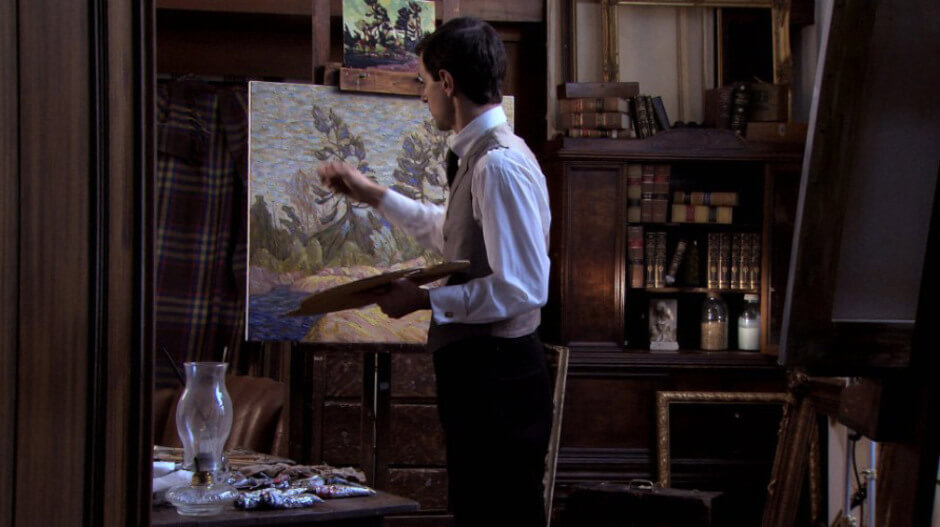
Film
Of these three films, one tries to answer some of the questions raised about Thomson’s death (A Documentary Investigation into the Death of Tom Thomson); one strives to deal with his life in a quasi-fictional way (The Far Shore)—the tug between art in the wilderness and the comforts of high society in Toronto’s Rosedale; and one is a brilliant and beautiful feature documentary (West Wind), with much new information, gorgeous photography, and a close look at Thomson’s paintings, with commentary from knowledgeable curators and critics.
Hozer, Michèle, dir., and Peter Raymont, prod. West Wind: The Vision of Tom Thomson. Toronto: White Pine Pictures, 2011. Filmstrip, colour, 95 min.
Vaisbord, David, dir. Dark Pines: A Documentary Investigation into the Death of Tom Thomson. Vancouver: Laughing Mountain Communications, 2005. DV cam, colour, 48 min.
Wieland, Joyce, dir. The Far Shore. Toronto: Far Shore Inc., 1976. 35mm film, colour, 105 min.

 About the Author
About the Author
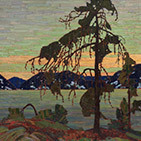 More Online Art Books
More Online Art Books
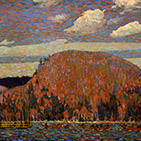 Acknowledgements
Acknowledgements